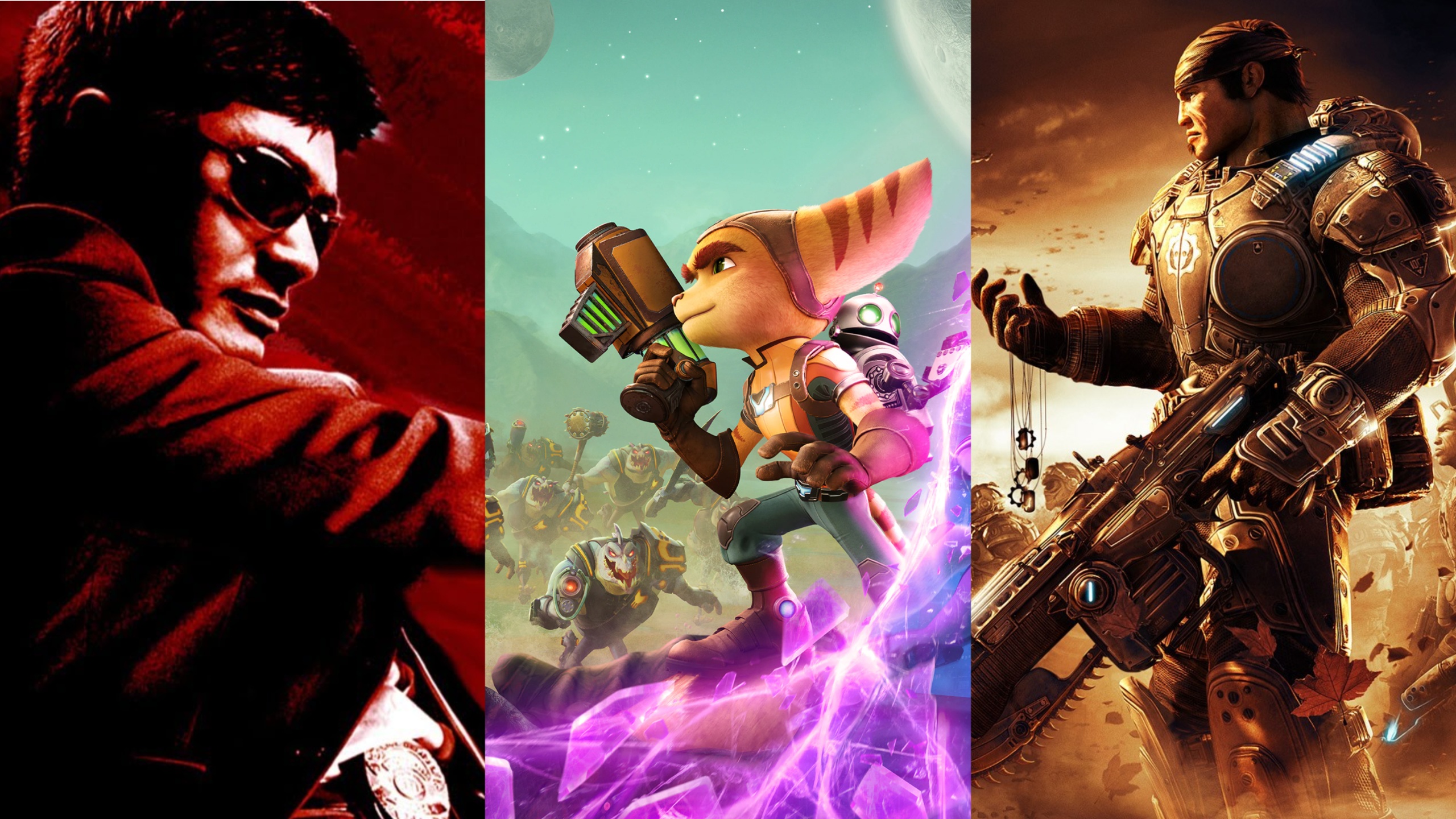
The third-person shooter genre is an odd part of gaming history. It’s much younger than you think, it’s dipped in and out of popularity over the years, and, culturally, it doesn’t necessarily enjoy the same mainstream renown that FPS games are typically afforded. There are times when you have to stop and really consider the third-person shooter to be its own genre.
Yet, the third-person shooter’s influence can be felt in so many aspects of the modern gaming industry. An important part of the evolution of true 3D gaming, third-person shooters quickly became a vehicle that allowed developers to experiment with how players were going to move through, interact with, and, yes, fight in increasingly complex 3D environments. Their cinematic style and chaotic action helped them stand out early on, and they eventually laid the foundation for the combat that so many modern titles rely on to some degree.
Of course, the prolific nature of that combat style has sometimes contributed to the complexity of identifying this genre. So even though we know some in the comments will not bother to read this clearly marked section, here are a few of the rules we followed when selecting the candidates for this list:
– 2D games and games that offered a prominent first-person perspective option were not considered eligible for this list. However, games that feature minor first-person moments like aiming down sights (ADS) were eligible.
– To separate third-person shooters from games with third-person combat, we focused on titles that emphasized combat as the main gameplay feature. So, while games like Red Dead Redemption and GTA 5 feature generally exceptional third-person action, their various open-world activities ultimately made them stray a bit too far from the spirit of this list.
– Finally, this is a list of third-person “shooters” which means that 3D action games without any or much shooting (God of War, Batman: Arkham Asylum, etc.) were not in contention.
With that out of the way, let’s dive into the rankings:
30. 50 Cent: Blood on the Sand
Gear of War quickly established a new era for third-person cover shooters. After that game launched, many games followed in its footsteps, which resulted in quite a few lackluster clones. Remarkably, a sequel to a lackluster third-person shooter starring 50 Cent isn’t one of these titles.
50 Cent: Blood on the Sand is a ludicrous third-person shooter where 50 Cent and his crew shoot their way across the Middle East because someone stole a gem-studded skull. That’s about the long and short of the narrative, but you don’t play a game starring 50 Cent for the plot. Blood on the Sand mixes polished, if somewhat standard, cover shooting with an arcadey points system that rewards players for stylish kills and completing objectives. These factors combine with the bombastic presentation that is 50 Cent’s voice and music to create a banger of a title. – Aaron Greenbaum
29. Kill Switch
Though Kill Switch is sometimes credited with inventing cover-based third-person shooter gameplay, that’s not entirely accurate. Kill Switch was inspired by similar cover systems previously seen in games like Metal Gear Solid 2, Winback, and, most notably, Time Crisis. However, Kill Switch was the game that dared to see if an entire action gaming experience could be designed around a modified version of that relatively rarely seen concept.
The results were truly groundbreaking. Though outdated in many ways by today’s standards, Kill Switch really could be considered the first “modern” third-person shooter. It opened up entirely new ways to look at (and play through) action gaming as a concept, and it directly inspired a few of the bigger names that will appear on this list. It was a true turning point for the genre and an incredibly entertaining action game in its own right. – Matthew Byrd
28. Mercenaries: Playground of Destruction
Though released in 2005, Mercenaries remains the cure for the modern open-world game in many ways. Whereas too many supposedly open-world titles are actually more interested in quietly shepherding you between a series of pre-planned experiences, Mercenaries embraced the idea of causing as much third-person action chaos as possible in a sandbox environment.
Mercenaries really wanted you to feel like the star of an action movie of your own design. Games like GTA: San Andreas may have wanted you to go nearly anywhere and do almost everything, but they never embraced the chaotic destruction of your environment and everyone in it quite like Mercenaries did. Developer Pandemic’s willingness and ability to cater to that aspect of the sandbox experiences made Mercenaries an eye-opening glimpse into the joyful possibilities of the still-emerging third-person shooting scene. Though Mercenaries 2 tragically dropped the ball, the Just Cause series (and others) eventually built upon this game’s ironically indestructible foundation. – MB
27. Alan Wake
After Remedy Entertainment finished work on Max Payne 2, the company decided to change direction. The studio still wanted to create a third-person shooter, but this time they wanted something a little less linear and inspired by the likes of Stephen King. The result was Alan Wake.
Alan Wake is the story of the novelist Alan Wake as he tries to fight against a dark, eldritch entity. The resulting story channels the magic and mystery of its inspirations, as players are never sure what will happen next except that it will leave them on the edge of their seats. Moreover, Alan Wake is a masterclass of design thanks to its uncanny ability to turn a welcoming Pacific Northwest town and its surrounding forests hostile with just a shift in lighting and atmosphere. Light is a key component to not only navigation but also survival. All of the game’s pieces come together to form an experience so unforgettable that fans were willing to put up with a two-decade wait in order to play its (slightly less action-focused) sequel. – AG
26. Ghostbusters: The Video Game
Licensed video games have a bad rap because they are rarely as good as the source material. In fact, many licensed games are straight-up bad, regardless of the quality their originators displayed. Many of these games lack the same magic because they don’t include the same creative team, but when those writers help create a licensed video game, a miracle occurs.
Ghostbusters: The Video Game is more or less the long-lost third Ghostbusters movie we never got (at least before Ghostbusters: Afterlife was released). Ghostbusters: The Video Game plays a lot like Gears of War lite, but instead of shooting various guns at members of the Locust Horde, players fire proton wands at ghosts, with the most powerful ones requiring a ghost trap finisher. The gameplay is fun on its own, but Ghostbusters: The Video Game excels in presentation. Not only does most of the Ghostbusters movie cast reprise their roles, but the writers of the film, Dan Aykroyd and Harold Ramis, also penned the game’s script. Aykroyd and Ramis’ participation and dialogue help give Ghostbusters: The Video Game that extra bit of love and kick in the right direction to make it feel like an interactive, bona fide Ghostbusters movie. – AG
25. Control
After Remedy Entertainment found success with Alan Wake, audiences clamored for a sequel. Instead, the company developed Quantum Break: a game unrelated to that title. While Remedy eventually released Alan Wake 2, the company took a detour into a kind of stealth successor first.
At its core, Control is a Metroidvania shooter that takes heavy inspiration from the fictional SCP Foundation (an organization dedicated to securing, containing, and protecting various anomalies). As players explore the winding and occasionally non-Euclidian corridors of Control’s world, they obtain abilities and weapons that let them unlock previously inaccessible areas. The game excels at worldbuilding and making players feel like they are barely scratching the surface of an otherworldly setting and an equally otherworldly menace. Plus, Control just oozes style. While the game’s tone is primarily (and intentionally) dour, it isn’t afraid to inject small comedic bits and pulse-pounding setpieces that almost always hit their mark. If you want an exciting third-person shooter Metroidvania or just want a way to test the raytracing capabilities of your graphics card, Control is a must. – AG
24. James Bond 007: Everything or Nothing
Though Bond games will probably always be popularly associated with first-person combat thanks to GoldenEye, there have been a few notable third-person Bond games released over the years. However, none of those titles achieve quite what Everything or Nothing achieves.
Everything or Nothing isn’t just an original Bond story; it’s practically a lost Bond film. Every element of this experience is designed to resemble the most elaborately cinematic aspects of a Bond movie, and you get to play through the whole thing. This title’s third-person action not only lets you view the full splendor of its production values (and appreciate seeing Brosnan as Bond one more time) but contributes to some surprisingly strong action setpieces that rank high among Bond’s most memorable gaming moments. – MB
23. Resident Evil 4 (Remake)
2005’s Resident Evil 4 arrived at a particularly stagnant time for the survival horror genre. Though horror masterpieces were regularly being released, many still followed in the footsteps of those groundbreaking ‘90s genre titles. Crucially, many were also struggling to really make a sales impact in the rapidly changing marketplace. Well, Capcom managed to disrupt the survival horror industry once again by embracing both the third-person shooter genre and elements of emerging cinematic action experiences.
Though that game’s brilliance is hard to deny, the Resident Evil 4 remake gets a slight (yet crucial) nod here. That remake balances action and horror better than even the original game did, which is quite remarkable when you consider how much more action-heavy it is than something like the exceptional Resident Evil 2 remake. This game’s surprisingly strong combat is at the heart of the experience, but your enhanced ability to defend yourself almost never clashes with the intended and effective scares. – MB
22. Splatoon 2
Nintendo is synonymous with several genres, most notably platformers and RPGs. Conversely, few people ever expected Nintendo to greenlight survival horrors and shooters. However, the company turned the horror genre on its head with Luigi’s Mansion, and it did the same with third-person shooters.
Nintendo’s Splatoon franchise is as wonderful a collection of third-person shooters as they are colorful. While the games have a campaign mode, the multiplayer is where most of the action is. Instead of encouraging players to shoot their enemies to gain points, all modes revolve around the novel concept of a paint-themed turf war. Each team has to paint as much of the town as they can red (or whatever their squad color is). Every Splatoon game is worth playing, but for our money, we think Splatoon 2 is the best of the bunch since it added so much more content than the first entry. Plus, it might be DLC, but the Octo Expansion is hands down the franchise’s best single-player campaign, bar none. – AG
21. Transformers: Fall of Cybertron
In 2010, High Moon Studios released the best video game based on the Transformers license: Transformers: War for Cybertron. At least, audiences thought it was the best until the company released a follow-up that improved on what came before.
Like its predecessor, Transformers: Fall of Cybertron serves as an origin story of sorts for the Transformers franchise since it takes place on the planet of Cybertron during the height of the Autobot/Decepticon war. Instead of relying on cover shooting, Fall of Cybertron (and, by extension, War for Cybertron) is more fast-paced since each character can transform and use special abilities. These systems help each level and character feel unique, not only when compared to the rest of the game but also other third-person shooters in general. Moreover, the level of detail put into animations and sound design makes Fall of Cybertron come off as a labor of love. While Transformers: Fall of Cybertron caters to fans of the Transformers property due to innumerable small details and references, it is approachable to newcomers as well. – AG
20. Dino Crisis 2
Truth be told, I’ll take any excuse I can to write about the eternally underrated Dino Crisis 2. It was a truly incredible game that also offered a clear glimpse into the future of third-person shooters at a time when that genre was still trying to find its feet.
While the previous Dino Crisis game encouraged you to run away from dinosaurs Resident Evil-style, Dino Crisis 2 often asked you to blast them straight to Jurassic hell. Doing so would earn you combo points that could then be used to purchase new weapons and gear. It was an arcade-like approach to survival horror that not only felt like a preview of the Devil May Cry era of action gaming but allowed Dino Crisis 2 to function as the Aliens to Dino Crisis’ Alien. – MB
19. Warframe
Digital Extremes started its life helping other companies develop their games (e.g., Digital Extremes coded the multiplayer mode of BioShock 2), but the studio’s luck started turning around when it finally produced its own IPs. However, Digital Extremes didn’t experience true success until it published Warframe.
Warframe is a stylish third-person shooter/hack-and-slash title where players control one of an ever-growing list of high-tech suits (the titular Warframes). Each Warframe has its own stats and abilities, most of which are insanely creative, and they can effortlessly move across levels with the speed and grace of a ninja. Half the fun of Warframe is just parkouring through levels and effortlessly slaughtering enemies; the other half stems from the presentation. From the art to the sound, you’ve never played a game quite like Warframe. While players have to grind upon grinds to collect all of the game’s weapons and Warframes, it’s well worth the effort. Plus, unlike every other entry on this list, Warframe is free-to-play, so you can start downloading it as soon as you’re done reading this article. – AG
18. Warhammer 40K Space Marine
Games Workshop’s Warhammer 40K franchise has been around since 1987, but it has only received the more mainstream attention it deserved within the last few years. Still, developers tried their hands at video game adaptations every now and then over the years. This one truly captured what the average day looked like for the series’ most famous faction.
Warhammer 40K Space Marine places players in the boots of a titular Space Marine, and it’s their job to secure an entire planet against the forces of invading aliens and later demons. What the game lacks in story it more than makes up for in performance and presentation. Space Marine utilizes brutal combat and gory animations to make players feel like a futuristic, 2,000-pound super soldier who is still fairly mobile despite wielding more firepower and armor than most modern tank battalions. Plus, Space Marine sports nails the loo, atmosphere, and general grandiosity of the Warhammer 40K universe. The game is just plain fun, but since the narrative is so simple, it can also help ease newcomers into the Warhammer 40K IP. You know a game is good (and its developers loved their work) when it can turn a weakness into a strength. – AG
17. Vanquish
Though it really shouldn’t surprise anyone to learn that developer Platinum Games made a third-person action title with exceptional combat, Vanquish really is a uniquely exceptional third-person shooter experience.
I’ve never had a religious experience in the traditional sense of the phrase, but the first time I powerslided across a level in Vanquish felt remarkably close to how people describe such sensations. What initially seems to be a hilarious movement system gimmick soon proves to be the backbone of an absurdly wonderful action experience that never asks you to slow down for longer than is strictly necessary. Though Vanquish sometimes feels like a proof of concept for a more substantial experience, it’s just a ridicolously fun time. – MB
16. Fortnite
Though there have certainly been popular multiplayer third-person shooter games, you’re not alone if your mind jumps to first-person shooters when you think of the biggest competitive multiplayer titles. The first-person perspective often lends itself to an inherently more competitive, skill-based experience. Well, Fortnite isn’t just the most notable exception to that trend; it’s a game that practically built its considerable empire on the back of the advantages of that perspective.
Specifically, Fortnite got a lot of mileage (and money) out of being able to see your character, how they look, and what they’re doing. Skins and other cosmetics have long been prized in multiplayer games, but Fortnite turned the enhanced visual access you get from that perspective into a culture. Perhaps more importantly, Fortnite’s third-person perspective better allowed for the game’s iconic “build” gameplay, a variety of special events, and a massive influx of personality while leaving just enough room open for a genuinely competitive atmosphere. – MB
15. Binary Domain
Ryu Ga Gotoku Studio has become a household name as of late. This in-house development branch of Sega has gone through several names and has helped steer the Yakuza franchise to prominence ever since Yakuza 5. However, before the studio released that game, it developed its only third-person shooter, Binary Domain.
In Binary Domain, players command a squad of allies in order to uncover a conspiracy revolving around rogue robots that can disguise themselves as human. What unfolds is an action-packed shooter where players fight through waves of androids and other weaponized machines. While the shooting is as you’d expect from a cover shooter, Binary Domain stands out thanks to a dynamic AI system that makes enemies react to where they’re shot. Cripple their legs, and they start crawling towards you. Knock their head off, and the robots start firing blindly, potentially hitting their allies. Moreover, Binary Domain really hammers its reliance on squad shooter mechanics. Not only do players need to provide smart commands in order to survive, but many interactions affect in-game relationships, which impact the ending. If it weren’t for Terminator: Resistance, Binary Domain would be the best Terminator game out there despite having no connection to the IP. – AG
14. Earth Defense Force
Sometimes, you just have the urge to watch a fun, stupid movie that lets you turn your brain off and enjoy the spectacle. Earth Defense Force is that very kind of video game.
Each Earth Defense game has the same plot: Save the world from invading aliens. That’s it, but boy is it a blockbuster of a ride. Instead of fighting actual aliens, players fend off their minions that take the form of giant insects, dragons, and the occasional Godzilla stand-in. The game throws so many enemies at players that its engine buckles under the load, but to keep the odds fair, players can use all manner of weaponry, from paltry shotguns to orbital death lasers and even giant mechs. The spectacle and constant grind will keep players coming back for more, especially if they utilize the multiplayer. What’s more enjoyable than nuking millions of giant ants? Nuking millions of giant ants with friends. – AG
13. Dead Space (Remake)
The original Dead Space (and its exceptional recent remake) was a landmark release in the evolution of action horror. By encouraging you to slow down and target the limbs of unspeakable monstrosities, Dead Space allowed you to defend yourself without allowing you to ever feel truly empowered.
Well, the recently released Dead Space remake simply perfects Dead Space’s already exceptional third-person shooting. Most notably, the remake improves upon the visual elements of the original game’s dismemberment system, which really lets you appreciate both the chaos of your work and the satisfaction of landing that perfect shot despite panicking. – MB
12. Sunset Overdrive
There’s a degree to which Sunset Overdrive has always been too weird to live. Though it shares a few things with some of Insomniac’s previous works (most notably, the Ratchet and Clank series), it was a true experiment for the acclaimed studio. At the very least, that’s the best way I can think to describe a game that is one part Jet Grind Radio, one part third-person shooter, and one part zombie apocalypse comedy game. Even its initial Xbox One exclusivity feels so odd in retrospect.
For all of its quirks, though, Sunset Overdrive really does offer an irreplaceable experience for those interested in attuning themselves to its wavelength. That’s especially true of the game’s wonderful (though surprisingly challenging) third-person combat system. Imagine playing a Tony Hawk game where you’re occasionally asked to pick off mutants while performing tricks, and you’ll have an idea of what Sunset Overdrive is going for. It’s one of the most incredible blends of movement and combat I’ve ever experienced, and I’m not sure I would trust anyone other than Insomniac to pull something quite so wild off nearly as well. – MB
11. Freedom Fighters
Freedom Fighters is set in a Red Dawn-like alternate world where the Soviet Union has taken control of New York City. You play as a freedom fighter desperately trying to liberate the city from a superior force. Along the way, you’ll need to build up your reputation in order to recruit people to your cause and convince them to fight alongside you.
Though its third-person shooting mechanics aren’t quite as strong as what you’ll find in the genre’s smoothest offerings, its Freedom Fighters’ origins as a strategy game help make its action stand out from nearly everything else out there. Even in a relatively limited form, that mechanic not only adds a necessary level of depth to the combat but enhances the narrative and stylistic elements that Freedom Fighters into the realm of the truly special action experiences. – MB
10. Stranglehold
The post-Max Payne era of third-person shooters was filled with games that desperately wanted to follow in that title’s footsteps but often lacked the creative vision and refinements that made that title truly exceptional. Well, Stranglehold may not quite match Max Payne’s artistic heights, but it is certainly equal in terms of sheer spectacle and pure fun.
Appropriately based on the works of John Woo (the godfather of this entire style of cinematic gunplay), Stranglehold often intends to be as absurd as possible. Nearly every gunfight in this game (and there are a ton of them) see you kick off walls, slide down rails, and fly through the air as you fire off a million bullets in glorious slow motion. It may be Max Payne’s slightly trashier cousin, but you’ll have a hard time finding a more purely enjoyable third-person shooter to spend an evening with. – MB
9. Remnant 2
As the newest game on this list, Remnant 2 was not only tasked with improving upon its exceptional predecessor but following in the footsteps of so many third-person action titles that preceded it. In the year 2023, what else can a third-person shooter show us that we haven’t seen before?
Yet, Remnant 2 manages to separate itself from so much out there through its often surprising depth. While said depth certainly extends to the wealth of surprisingly involved activities the game has to offer, it crucially also applies to the game’s combat. At a time when so many action titles want to pass themselves off as RPGs, Remnant 2 finds ways to make you consider your gear, character, and strategic choices without ever compromising the pure enjoyability of its core action gameplay. – MB
8. Uncharted 2: Among Thieves
Though the Uncharted games don’t emphasize shooting nearly as much as some of the other titles on this list, you shouldn’t underestimate that part of the experience. While Uncharted’s platforming and incredible cinematic sequences instantly elevated it above many of the Tomb Raider games that had come before, it was actually the series refined action that helped make it feel so special compared to everything that came before.
Interestingly enough, Uncharted 2 really lets you appreciate the joys of that third-person shooting by generally featuring a little less of it. Uncharted 2 may not always throw you into a shooting sequence, but the third-person shooting that is in this game feels mechanically tighter and far more impactful. Uncharted 2 is still one of the most reliable sources for gaming’s greatest setpiece shootouts. – MB
7. Metal Wolf Chaos
FromSoftware is synonymous with two franchises: Armored Core and Dark Souls (and by extension all its Soulsborne successors). However, the company has developed plenty of other IPs, some of which didn’t try to be quite so serious.
Metal Wolf Chaos used to be a Japan-exclusive mech shooter where players controlled a gun-toting mech piloted by the President of the United States, but in 2019, Devolver Digital released the game stateside as Metal Wolf Chaos XD. Name and platforms aside, both titles are the same experience: balls-to-the-wall action amplified by a clear sense of fun. The game plays like a stripped-down version of early Armored Core games with an emphasis on arcadey action and comedic cutscenes. Metal Wolf Chaos is a product of its time, which is demonstrated by its bosses and difficulty curves, but these issues don’t detract from the sheer ridiculous factor of blowing everything up as the President of the United States. It certainly isn’t for everyone, but it is yet another example of a third-person shooter you can enjoy if you shut your brain off. With any luck, FromSoftware will return to this style of gaming in the future. – AG
6. Psi-Ops: The Mindgate Conspiracy
Psi-Ops is one of those titles that people often love and fondly remember to a sometimes frightening degree. That’s partially because it went relatively overlooked in its day and in the many years since, but it’s also because this endlessly inventive game is about as entertaining as a third-person shooter can possibly get.
Understandably, the highlight of Psi-Ops physics-based action sequences isn’t its shooting but rather your character’s arsenal of powerful psychic abilities. However, that makes it all the more impressive that developer Midway incorporated those abilities into a game that offered fundamentally impressive third-person shooting combat. Tossing enemies about and setting them on fire was always a good time, but it was made that much better by the opportunity to weave those skills into wonderfully intense firefights. – MB
5. Returnal
Though I was excited that developer Housemarque was getting the chance to work on a bigger project with Returnal, I was a bit saddened by some of the initial details that emerged about that project. After all, Housemarque had previously established itself as one of the great protectors and proponents of arcade-like action experiences. Could they really translate that style of gameplay to a 3D Metroidvania horror title with a time loop narrative kicker?
Remarkably, the answer is a resounding, “Yes.” There are many great things to say about Returnal, but the quality of the game’s combat remains its most surprising and impactful feature. It’s essentially a holy union between a bullet hell shooter and a pure third-person action title, and it keeps enthralled no matter how overwhelming things get. Your reflexes will be challenged and your efforts will be rewarded time and time again. The fact I had to pause and consider this game’s eligibility is more of a testament to everything that Housemarque builds around that nearly perfect combat. – MB
4. Ratchet & Clank: Rift Apart
Since 2002, the Ratchet and Clank series has been a safe harbor for third-person shooting fans everywhere. Developer Insomniac Games quickly tapped into the joyful chaos that comes when you allow players to run around gorgeous environments and blow up seemingly endless waves of enemies with the help of increasingly elaborate weaponry. It wasn’t a new concept by any means, but Insomniac quickly figured out how it should work in 3D and spent the next couple of decades refining that concept.
Well, Rift Apart is basically a celebration of the series’ evolution. Through the power of the PS5, Insomniac was able to increase the scope of the Ratchet and Clank experience without expanding the size of the game to the point that it loses its simplest pleasures. The result is a relentlessly entertaining third-person shooter that boasts the visuals of a proper next-gen experience while tapping into the personality-driven arcade-like action that never seems to age when it’s done this well. – MB
3. Spec Ops: The Line
So many shooting games use modern military battlegrounds and weaponry that “military shooter” is its own sub-genre within the first and third-person shooter industries. Many military shooters rely on a series of well-worn tropes, and Spec Ops: The Line is a deconstruction of them all.
Spec Ops: The Line starts off as a normal squad-based shooter. Players have access to standard military weaponry, can command allies to perform certain actions, and hide behind cover. However, what makes Spec Ops: The Line truly special is its narrative. Each decision players make affects their relationship with their squadmates, but the most no matter what players do, they are forced to continue on like a good soldier, no matter the physical and psychological cost. Spec Ops: The Line taunts players and makes them feel the weight of every decision, even when the “decision” was nothing more than following an objective provided by the game. The game provides a poignant message about the cost of war and armed conflict, one that wouldn’t be half as effective in a non-interactive medium. – AG
2. Gears of War 2
2006’s Gears of War really was a lightning bolt moment for third-person shooters and gaming, in general. Though not quite the first game of its kind, GoW’s cover-based action was executed with a kind of style and confidence that had never really been seen before. It was a weighty, meaty shooter that kicked down the doors of next-gen gaming and clearly announced that the future was here. That said, it was not without its faults. Even at the time of its release, there were many who said that it felt like GoW could offer…well…more.
“More” is exactly what Gears of War 2 offers. It’s a larger, more refined, and generally more ambitious experience that never forgets that the fundamental pleasure of this franchise comes from blasting away an army of monsters from the relative sanctuary of cover before finishing off the survivors with your chainsaw bayonet. It wasn’t necessarily trying to refine or mature what this franchise was; it was trying to be the best and biggest version of an incredibly enjoyable experience. Most importantly, GoW 2 introduced the feature that would soon come to define the franchise and a very specific era of action gaming: Horde Mode. – MB
1. Max Payne 2
2001’s Max Payne is arguably the most important third-person shooter ever made. Released at a time when Hong Kong, slo-mo action was at its cultural apex due largely to the global impact of The Matrix, Max Payne translated that style of action to gaming while utilizing an exaggerated noir style that was all its own. Though controversial due to its various changes and new ideas, 2012’s Max Payne 3 later arguably perfected those shooting mechanics with refinements that are still widely utilized to this day.
So why does Max Payne 2 get the nod on this list? Well, it’s arguably the perfect blend of Max Payne’s stylistic innovations and refined gunplay. It also happens to be one of the “great games” regardless of genre.
Max Payne 2’s loving embrace of the Havok Physics engine resulted in gunfights that rarely played out the same way twice. They were chaotic, but they always felt like the proportionate consequences of your actions within the game’s hyper-exaggerated realm of cinematic violence. That visually and mechanically satisfying action was made all the sweeter by some of the best level design in action gaming history and a story that was far more emotional and surprising than anyone could have anticipated. This was the game that proved why Remedy is one of gaming’s truly special studios. – MB
The post 30 Best Third-Person Shooter Games Ever appeared first on Den of Geek.







